
The Śvetāmbara is one of the two main branches of Jainism, the other being the Digambara. Śvetāmbara in Sanskrit means "white-clad", and refers to its ascetics' practice of wearing white clothes, which sets it apart from the Digambara or "sky-clad" Jains whose ascetic practitioners go nude. Śvetāmbaras do not believe that ascetics must practice nudity.

Parshvanatha, or Pārśva and Pārasanātha, was the 23rd of 24 Tirthankaras of Jainism. He gained the title of Kalīkālkalpataru.
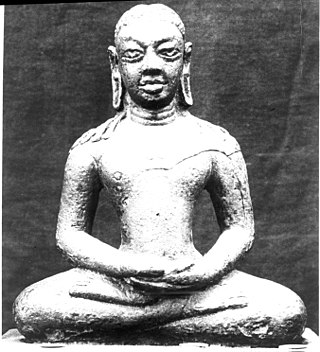
This was the first known bronze hoard discovered in the Gangetic valley and consists of a set of 18 Jain bronzes. The Chausa hoard, thus named after the place of discovery: Chausa or Chausagarh is located in the Buxar district of Bihar state, India.
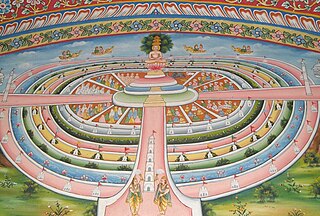
In Jainism, Samavasarana or Samosharana is the divine preaching hall of the Tirthankara, stated to have more than 20,000 stairs in it. The word samavasarana is derived from two words, sama, meaning general and avasara, meaning opportunity. It is an important feature in Jain art. The Samavasarana seems to have replaced the original Jain stupa as an object of worship.

Munisuvrata or Munisuvratanatha was the twentieth Tirthankara of the present half time cycle (avasarpini) in Jain cosmology. He became a siddha, a liberated soul which has destroyed all of his karma. Events of the Jaina version of Ramayana are placed at the time of Munisuvrata. Munisuvrata lived for over 30,000 years. His chief apostle (gaṇadhara) was sage Malli Svāmi.
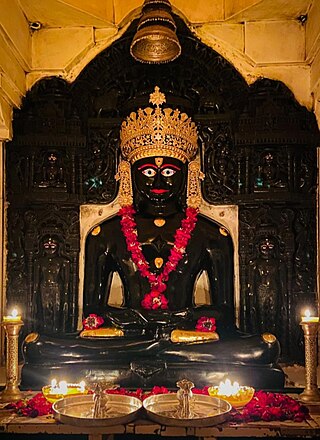
Neminātha, also known as Nemi and Ariṣṭanemi, is the twenty-second Tīrthaṅkara of Jainism in the present age. Neminatha lived 81,000 years before the 23rd Tirthankara Parshvanatha. According to traditional accounts, he was born to King Samudravijaya and Queen Shivadevi of the Yadu dynasty in the north Indian city of Sauripura. His birth date was the fifth day of Shravana Shukla of the Jain calendar. Krishna, who was the 9th and last Jain Vasudev, was his first cousin.

Maharaja Chhatrasal Museum is a museum located in an old palace at Dhubela, on the Chhatarpur-Jhansi highway, in Chhatarpur District, Madhya Pradesh, India. This museum was established in September, 1955 in a palace built by Chhatrasal for his residence. Presently, the museum comprises 8 galleries, of which two galleries display inscriptions, copper plates, Sati pillars, lingas and inscribed images of the Gupta and Kalachuri period. The museum houses a wide range of sculptures of the Shakti cult. It has also a significant collection of Jaina images. It also displays the garments, weapons and paintings of the Bundela kings.
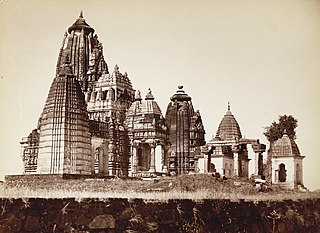
The Jain temples of Khajuraho are a part of the UNESCO World Heritage Site of Khajuraho. They are located in Chhatarpur district, Madhya Pradesh, India, about 175 kilometres southeast of the city of Jhansi.

In Jainism, Ambika or Ambika Devi is the yakshini "dedicated attendant deity" or Śāsana Devī "protector goddess" of the 22nd Tirthankara, Neminatha. She is also known as Ambai, Amba, Kushmandini and Amra Kushmandini. She is often shown with one or more children and often under a tree. She is frequently represented as a pair with a small Tirthankar image on the top. The name ambika literally means mother, hence she is Mother Goddess. The name is also a common epithet of Hindu Goddess Parvati.

Jain sculptures or Jain idols are the images depicting Tirthankaras. These images are worshiped by the followers of Jainism. The sculpture can depict any of the twenty-four tirthankaras with images depicting Parshvanatha, Rishabhanatha, or Mahāvīra being more popular. Jain sculptures are an example of Jain art. There is a long history of construction of Jain sculptures. Early examples include Lohanipur Torsos which has been regarded to be from the Maurya period, and images from the Kushan period from Mathura.

Jain art refers to religious works of art associated with Jainism. Even though Jainism has spread only in some parts of India, it has made a significant contribution to Indian art and architecture.

Kankali Tila is a mound located at Mathura in the Indian state of Uttar Pradesh. The name of the mound is derived from a modern temple of Hindu goddess Kankali. The famous Jain stupa was excavated here in 1890-91 by Alois Anton Führer.
Umakant Premanand Shah was a scholar from India.

Jivantasvami images represent the Jain Tirthankara Mahavira as a prince, with a crown and ornaments. The Jina is represented as standing in the kayotsarga pose. Jivantasvami images have been used only in the Shvetambara Jain tradition, they are unknown in the Digambara tradition.
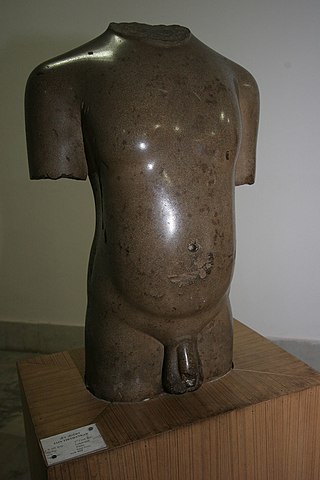
The Lohanipur torso is a damaged statue of polished sandstone, dated to the 3rd century BCE ~ 2nd century CE, found in Lohanipur village, a central Division of Patna, ancient Pataliputra, Bihar, India. There are some claims however for a later date, as well as of Graeco-Roman influence in the sculpting.The Lohanipur torso is thought to represent a Jaina Tirthankara.
The Aluara Bronzes or Aluara Hoard represent a rare and important set of Jain images found in Aluara near Dhanbad region of Bihar, in Eastern India.
In 1956, 240 Jain bronze idols were discovered dating back to early medieval to medieval period. The Vasantgarh hoard, thus named after the place of discovery, Vasantgarh is located in the Sirohi District of Rajasthan, India.
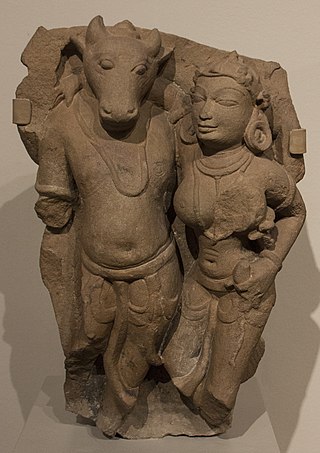
In Jain cosmology, Gomukha is the guardian god or Yaksha of Rishabhanatha, the first Tirthankara.

The Jain stupa was a type of stupa erected by the Jains for devotional purposes. A Jain stupa dated to the 1st century BCE-1st century CE was excavated at Mathura in the 19th century, in the Kankali Tila mound.

The Pārśvanātha āyāgapaṭa, is a large stone slab discovered in Kankali which has an image of Parshvanatha, dating back to reign Sodasa, of Indo-Scythian Northern Satrap, the ruler Sodasa in Mathura. The tablet in the State Museum Lucknow. It is an important example of Mathura art.






















